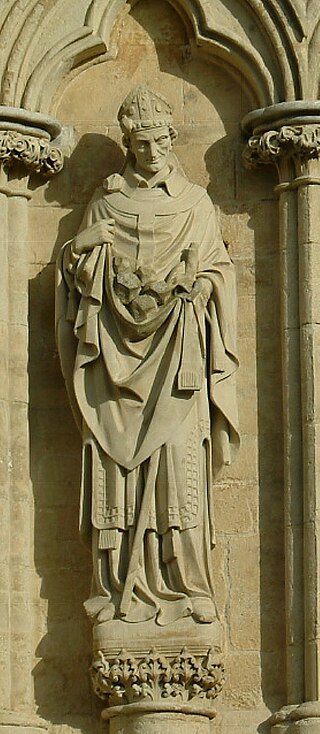Related Research Articles

Ælfheah, more commonly known today as Alphege, was an Anglo-Saxon Bishop of Winchester, later Archbishop of Canterbury. He became an anchorite before being elected abbot of Bath Abbey. His reputation for piety and sanctity led to his promotion to the episcopate and, eventually, to his becoming archbishop. Ælfheah furthered the cult of Dunstan and also encouraged learning. He was captured by Viking raiders in 1011 during the siege of Canterbury and killed by them the following year after refusing to allow himself to be ransomed. Ælfheah was canonised as a saint in 1078. Thomas Becket, a later Archbishop of Canterbury, prayed to him just before his own murder in Canterbury Cathedral in 1170.
Lyfing was an Anglo-Saxon Bishop of Wells and Archbishop of Canterbury. He was abbot of Chertsey Abbey before becoming bishop at Wells. His appointment to Canterbury came at a time of Danish invasions of England, and he was unable to act as archbishop for a time due to Danish activity. When Cnut, the Danish king, became king of England, Lyfing likely consecrated the new king. Lyfing was known as a wise man and gave gifts to his church and oversaw repairs to his cathedral before his death in 1020.
Lyfing of Winchester was an Anglo-Saxon prelate who served as Bishop of Worcester, Bishop of Crediton and Bishop of Cornwall.
Æthelnoth was the archbishop of Canterbury from 1020 until his death. Descended from an earlier English king, Æthelnoth became a monk prior to becoming archbishop. While archbishop, he travelled to Rome and brought back saint's relics. He consecrated a number of other bishops who came from outside his archdiocese, leading to some friction with other archbishops. Although he was regarded as a saint after his death, there is little evidence of his veneration or of a cult in Canterbury or elsewhere.
Sigeric was the Archbishop of Canterbury from 990 to 994. Educated at Glastonbury Abbey, he became a monk there before becoming an abbot and then Bishop of Ramsbury before his elevation to the archbishopric. An account of his pilgrimage to Rome in 990 survives and is an important source for historians studying Rome during his lifetime.
Æthelgar was Archbishop of Canterbury, and previously Bishop of Selsey.
Ordbriht was a monk at Glastonbury, Winchester, and then Abingdon until 964 when he was appointed Abbot of Chertsey by Æthelwold; Ordbriht attests as Bishop of Selsey from about 989 to 1007 or 1008.
Ælfmær was an Anglo-Saxon Bishop of Selsey.
Æthelric I was an Anglo-Saxon Bishop of Selsey.
Hecca was an Anglo-Saxon Bishop of Selsey. According to the Anglo-Saxon Chronicle, Hecca was chaplain to Edward the Confessor and became bishop when Grimketel died in 1047. He was an Englishman, and a royal clerk. He died in 1057.
Ealdwulf was a medieval Abbot of Peterborough, Bishop of Worcester, and Archbishop of York.

Cynesige was a medieval English Archbishop of York between 1051 and 1060. Prior to his appointment to York, he was a royal clerk and perhaps a monk at Peterborough. As archbishop, he built and adorned his cathedral as well as other churches, and was active in consecrating bishops. After his death in 1060, the bequests he had made to a monastery were confiscated by the queen.
Ælfric of Abingdon was a late 10th-century Archbishop of Canterbury. He previously held the offices of abbot of St Albans Abbey and Bishop of Ramsbury, as well as likely being the abbot of Abingdon Abbey. After his election to Canterbury, he continued to hold the bishopric of Ramsbury along with the archbishopric of Canterbury until his death in 1005. Ælfric may have altered the composition of Canterbury's cathedral chapter by changing the clergy serving in the cathedral from secular clergy to monks. In his will he left a ship to King Æthelred II of England as well as more ships to other legatees.
Cyneweard was an Anglo-Saxon Bishop of Wells. He was a monk of Glastonbury Abbey before becoming abbot of Milton Abbey in 964. He was consecrated bishop of the Diocese of Wells in about 973 or 974, and died in office on 28 June 975. His death is mentioned in the short Old English poem "The Death of King Edgar", which occurs in the entry for 975 of two of the manuscripts of the Anglo-Saxon Chronicle.
Sigar was an Anglo-Saxon Bishop of Wells.
Duduc was a medieval Bishop of Wells.
Wulfsige was a medieval Bishop of Lichfield.
Leofwin was a medieval Bishop of Lichfield.

Walter Durdent was Bishop of Coventry from 1149 to 1159.
Burhweald was a medieval Bishop of Cornwall.
References
- Barlow, Frank (1979). The English Church 1000–1066: A History of the Later Anglo-Saxon Church (Second ed.). New York: Longman. ISBN 0-582-49049-9.
- Fryde, E. B.; Greenway, D. E.; Porter, S.; Roy, I. (1996). Handbook of British Chronology (Third revised ed.). Cambridge, UK: Cambridge University Press. ISBN 0-521-56350-X.
- Knowles, David; London, Vera C. M.; Brooke, Christopher (2001). The Heads of Religious Houses, England and Wales, 940–1216 (Second ed.). Cambridge, UK: Cambridge University Press. ISBN 0-521-80452-3.